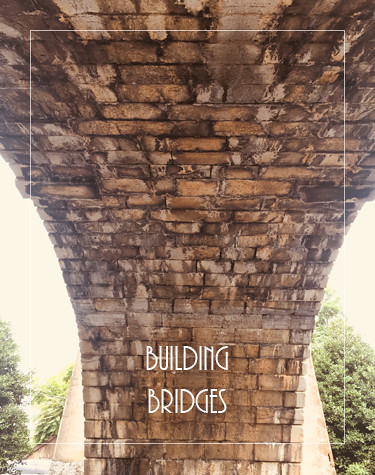
Volume XV, Issue XII
Günter Wendt
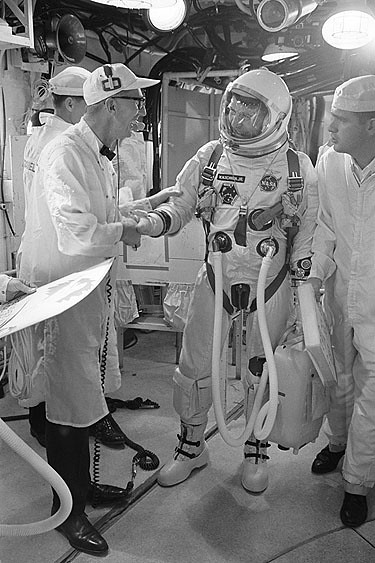
Günter Wendt offers his best wishes to Astronaut Walter M. Schirra Jr., command pilot, as he arrives in the white room atop Pad 19. NASA Photo.
As a young man in Germany, Günter Wendt studied mechanical engineering and became a flight engineer aboard Luftwaffe night fighters. He also completed a four-year apprenticeship during the war learning aircraft building. After the Allied victory there was not opportunity for aircraft engineers to be found in postwar Germany so Wendt immigrated to America where his Father lived in St. Louis, Missouri. Because of his background, he had the tentative promise of a job at the McDonnell Aircraft Plant. There was one problem. In 1949 Germany was still technically at war with the United States so he could not be hired immediately. He became a truck mechanic.
Eventually Wendt was hired and when McDonnell built the Mercury Capsules he went to Cape Canaveral to oversee the final assembly and launch. Beginning with Ham the Chimpanzee’s launch, Günter would go on to oversee the launches of human astronauts in the Mercury and Gemini programs. Wendt recalls a time when some congressman showed up before Ham’s launch and insisted on seeing the chimp. Well, Ham had had a rather intense day of testing and was in a foul mood. In spite of being warned that it might not be such a good idea, he went to see the chimp anyway. Ham, who was not impressed, threw chimp droppings at the man, scoring a direct hit on the congressman’s white shirt and tie!
Günter Wendt became good friends with the human astronauts who came to appreciate his no-nonsense approach to pad safety and his sense of humor. He knew the risks involved and sought to minimize them as much as he could. His position, largely self-defined was “Pad Leader.” Though he was a representative of the civilian contractor, he could call off a launch. John Glenn and the astronauts dubbed him “Pad Fuhrer” and someone even presented him with a Col. Klink helmet. Wendt became famous for joking around with the spacemen but he never forgot the serious nature of his position, saying: “Sometimes you have to make a stand, without caring what the consequences are. You have to be living with your own conscience. It does not matter if you lost a lot of money, or got fired. You can't be telling yourself later that you killed somebody because you screwed up. You have to live with your conscience.”
He got to know the astronauts and their families as well. He had these words for John Glenn’s wife before his famous flight in Friendship Seven: “Annie, we cannot guarantee you safe return of John. This would be lying. Nobody can guarantee you this – there is too much machinery involved. The one thing I can guarantee you is that when the spacecraft leaves it is in the best possible condition for a launch. If anything should happen to the spacecraft, I would like to be able to come and tell you about the accident and look you straight in the eye and say, 'We did the best we could.' My conscience then is clear and there is where my guideline is.”
After Gemini, North American Rockwell was building the Apollo capsules and Wendt moved on. After the terrible fire that killed astronauts Ed White, Roger Chaffee and Gus Grissom, Wally Schirra insisted that Wendt return to his old post for the launch of Apollo 7. North American’s president called him and assured him he would have the same authority he had had before and he remained through the Apollo program. In the movie, Apollo 13, he is briefly saluted by Tom Hanks, playing Jim Lovell, saying: “I vonder were Günter Wendt?” He was truly the last person who interacted with the astronauts before they were launched, closing the hatch before they took off. After the integrity of the capsule was tested and the hatch was sealed, Günter would evacuate the crew of the white room and they would proceed to the pad access roadblock where they could quickly return to the spacecraft should they be needed. Actually the : “I vonder were Günter Wendt?” quote comes from Apollo 7 astronaut Donn Eislee, but it sums up the respect and friendship all the astronauts felt for him. Wendt retired from NASA (actually North American) in 1989. He was married to his wife Herma for forty years and she proceeded him in death. Wendt died on May 3, 2010, at his home in Merritt Island, Florida, following congestive heart failure and a stroke. His survivors include his three daughters, Irina Thompson, Norma Wendt, and Sandra Taylor; five grandchildren; a great-grandson; and a great-great-grandson.
A “Failure of Imagination”
[click to read]
By Keith Bassham
Since viewing the film and reading the transcript, I have learned Borman did not coin that phrase, “a failure of imagination.” It was used at least once in an evangelistic situation. The evening before C. S. Lewis knelt and became, in his words, “the most reluctant convert in all of Christendom,” he had been walking and talking with his friend J. R. R. Tolkien. Lewis, though partially persuaded of the truth of Jesus Christ, was still full of objections. At one point Tolkien interjected, “Your inability to understand stems from a failure of imagination on your part!”
My wife and I have been watching space films lately. Not the fantasy, Buck Rogers kind. This is NASA/Discovery Channel stuff — that, and some dramatic series based on the real thing. We just finished the film that portrayed the capsule fire in which the three astronauts, Gus Grissom, Ed White, and Roger Chaffee, lost their lives February 21, 1967. Putting live men into space and returning them safely is an incredibly complex affair, and with all the moving parts, electronic glitches, mission outlines, and the unforeseen human element, problems will occur. Often they are minute in importance, simple to overcome, and without serious consequences. Others, well, there is always the unexpected. (read more)
Building Bridges
One of my favorite scenes in the movie: 'Remember the Titans' is the one where Gerry Bertier and Julius Campbell realize that they are indeed brothers. Though they are of different cultures in segregated Virginia, they come together as teammates and develop bonds that are far deeper. The film is one we should perhaps dust off in these difficult days and pause as well at the scene where the team runs at dawn to the battlefields of Gettysburg.Coach Herman Boone speaks:
Anybody know what this place is? This is Gettysburg. This is where they fought the Battle of Gettysburg. Fifty thousand men died right here on this field, fightin' the same fight that we're still fightin' amongst ourselves today.
This green field right here was painted red, bubblin' with the blood of young boys, smoke and hot lead pourin' right through their bodies. Listen to their souls, men:
I killed my brother with malice in my heart. Hatred destroyed my family.'
You listen. And you take a lesson from the dead. If we don't come together, right now, on this hallowed ground, we too will be destroyed -- just like they were. I don't care if you like each other or not. But you will respect each other. And maybe -- I don't know -- maybe we'll learn to play this game like men."
Indeed, upon learning of the death of the Reverend Honorable Clementa C. Pinckney and eight of his congregation, I read his biography on the church website. I grieved a brother. The man and I held dear the same things. He died loving the people of G-d and building the Unseen Kingdom. Reverend Pinckney and his little circle were co-laborers in my most cherished work.
Surely that would be a brief thought, only to be lost in the onslaught of politicized news to come in the days to follow.
But I had made a fatal miscalculation. I underestimated the G-d that Reverend Pinckney and I serve (the present tense in intentional, for I believe he stands in the Presence of our shared Master today). To know the true greatness of a man, look at his pupils! As the members of the congregation who had just lost loved ones at the hands of a depraved gunman stepped forward to extend forgiveness to him, I recognized the hand of the Divine in their lives.
As thousands lined the Arthur Ravenel Jr. Bridge, arms and hands joined,to remember and pray; the Divine was at work! Dr. Henry Blackaby tells us to look for G-d at work and join him in that work. That call is clear today.

Magic Garden Morning.
Once, I looked up and I saw Heaven, a world above me brightly shining. My heart cried for wings. I looked around me and saw pain and suffering. The world was grey. I looked down and I saw a child with tear stained cheeks I reached out and grabbed his hand he looked at me and smiled. I saw a flower bloom red and full of life. The child picked the red flower and turned to his mother. She stood alone sad and cold. The child gave the red flower to his mother and her hard face softened I looked and saw a blue rippling stream. The mother saw an old crippled man, who could not move his legs to get a drink. She carried the man to the stream and gave him water to drink. He cried tears of joy. I saw a yellow bird sing. The old crippled man learned the yellow bird’s song and shared it with all he could see and everyone who heard it would feel happy. I saw rainbows shoot across the sky. I went on my way reaching out, feeding the hungry, clothing the naked, caring for the sick, seeing for the blind, hearing for the deaf, befriending the friendless, singing to bring happiness, and loving the loveless. Then one day I looked back and realized I had wings all along. My wings had been the love reached out to heal others who were broken. My heart burst with joy.
-- Kristina Elaine Greer

Rainbows Over the Magic Garden.
Builders and Blessed Peacemakers
[click to read]
There is much news in these days. Not all of it is good, yet I firmly believe that beyond all the distractions there is great reason for hope. We have faced dark and troubling times before, yet we have seen the hand of the Divine work through ordinary people... and history was changed by it. So please join me in praying for the hand of the Divine to "give us wings," as my friend Kristina says, to do His bidding. We can, inspired by the Spirit of G-d, build His Kingdom! Here are some stories to spur us on. (read more)
The Wood Between the Worlds
from 'The Magician's Nephew' by C. S. Lewis
Photos by Bob Kirchman
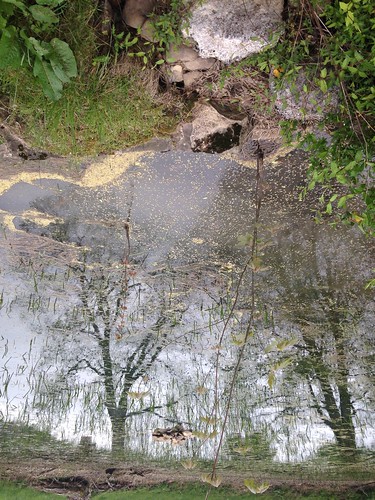
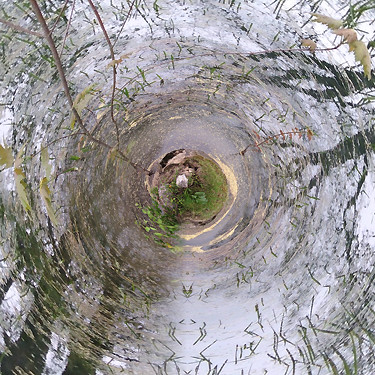
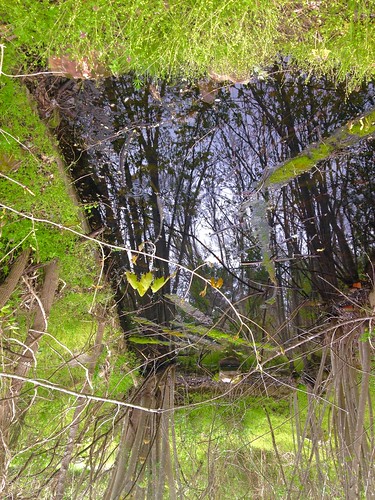
A rainy day in Augusta Wetlands evokes imagery from C. S. Lewis.
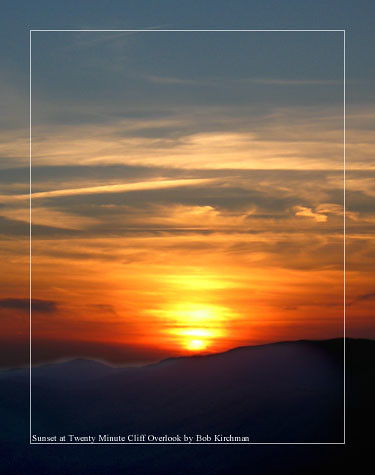
Sunset at Twenty Minute Cliff. Photo by Bob Kirchman.
A Case for Vision
Some Thoughts for Our Times
(The first in a series of articles originally presented in January of 2014)
The day was growing long as the evening light outside was fading away. I was installing the model our studio had built of a major resort in the welcome center. At 1" = 500' the physical model showed ski slopes, golf courses and a wonderful water park on a most amazing mountain location. The staff had quietly slipped in and out to look at the artistic rendition of the resort's majesty and many had expressed their admiration. I was hurrying to place the identifying numbers for the map key when I first noticed that I had an audience. Two teenagers had come in to look at the model up close. Their parents were already headed in to the indoor pool area but even the wonders of a world-class resort couldn't stop youth from being intrigued by a statement of vision.
One of the girls gazed at the model with what appeared to be skills of observation beyond her years. There was no need for the admonition: "Don't touch anything!" In fact, I would have considered it an insult. Both sisters displayed incredible respect for the work taking place before them. Though the first girl was quite conversant in literature (how many kids can use the words 'Utopian' and 'Distopian' in their conversation); Homeschoolers? Perhaps, but I didn't ask. Tolkien, Lewis and Rowling were better topics for conversation. The girls had clearly been raised to treasure literature and thought. That they lingered when a really fun moment awaited them through the next doorway spoke volumes to me. Young people (and I have been priviledged to work with the best in our studio) want to see vision and deserve to be shown our best efforts at it.
Most of my life has been spent in the field of visualization. It has involved constructing hundreds of little models of proposed projects, the drawing and painting of innumerable renderings and as the economy recently crumbled, some really interesting publishing projects. Vision is as essential to the soul as food is to the body, so, as S. Truitt Cathy says: "Make it good!" It is in our blood. It is a part of our history.
Michigan at the turn of the Century was poised to become a center of vision and innovation. My own ancestors fled Bavaria in 1870 as Otto von Bismark 'unified' Germany. They came to the American Northwest to settle in that cold land, finding employment on the growing railroad. The men set out first, seeking their fortunes, and saved their money to bring their ladies to the New World. When Oma arrived, she quickly decided she didn't like the boys working on Sunday, so they found work in Bay City's growing sawmill industry. Eventually Bay City would become known for pre-manufactured houses as Aladdin Homes and Lewis Homes would enter the market that Sears Roebuck is most famous for. The companies grew well into the Twentieth Century, but faltered during America's Great Depression.
Ironically it was during this same Depression, South of Bay City in Detroit, that Henry Ford's assembly line was creating an American version of the 'Industrial Revolution.' For a good portion of the Twentieth Century, Detroit was the automobile production center of the world. Across the 'glove,' in Benton Harbor, the Heath Company [click to read] began manufacturing a 'build it yourself' airplane kit. Expanding into consumer electronics, Heath offered a whole range of kits for enthusiasts who wanted to build their own radios and electronic devices. Heathkit became a legend as scores of people assembled and enjoyed these products. My father and I must have assembled dozens of them in my youth. My two brothers went on to become NASA engineers!
As Detroit diminished and Asian and European auto makers grew, one of my uncles worked for John Portman creating the great towers of Detroit's Renaissance Center. Today those gleaming towers preside over a city in decline. As Japanese and Korean companies remade the assembly line, Detroit's 'Big Three' were hobbled by antiquated methodology and union work rules. They had operated without fear of competition for so long that they came too late to the world of robotics and subcompact cars.
Great minds like that of Lee Iococca might have remade her, but Detroit was stubborn about resisting change and forgot about the deep well of her inventive past. It was not so much that they were 'stuck in the past' but that they were 'stuck in their own Century!' Had they looked to the past, they might have seen the transformation wrought in previous times by men like I. K. Brunel [click to read]. If some day we find ourselves gliding rapidly between cities in pneumatic tube transit systems, we will do well to remember that Brunel was there first. He used a pneumatic tube and piston to propel trains on one of his innovative railways in the Nineteenth Century!
The time was growing late. I asked my young observers a loaded question: "Why are there no books on how to teach your baby to walk?" They looked at me with a serious rumination I had often seen in the countenance of my studio assistant when I'd pose such a problem. "You don't need them!" one of the girls thoughtfully answered. She went on to explain that babies naturally want to stand and reach out to their full potential. "Why do we lose that?" I pondered. "Does it get 'taught out of us' as we move on to more formal instruction?"
And yet, it can be rekindled! It can be nurtured! As a boy I spent hours in the woods observing the wonders of the natural world. In 1964 the New York Worlds Fair inspired me to draw impossible built environments. Men walked on the Moon. My grandfather designed and built his own machinery for his mill. My grandmother was a great painter and designer. My mother loved mathematics and designing sweater patterns. My father wrote the procedures for testing spacecraft in the 1960's. Once Mom took me to visit a friend of hers who sculpted in white marble. Her friend encouraged me to work in Ivory Soap!
I do not consider my childhood to be all that out of the ordinary. This world is FULL of beautiful creative souls, most of whom LOVE to share their vision with young people. If it IS at all out of the ordinary, then I believe we are to blame for not allowing our children to come alongside and be infected by our brightest and best. History offers us even more. Consider the Wright Brothers [click to read]. Too often we've turned history class into: "What's Wrong with America" and neglected the stories of inspiration and greatness. That is not to say we should ignore the dark parts, but we must never create a picture of hopelessness and despair. There is too much evidence to the contrary!
My wife is an educator of young children. She once shared with me some research about early childhood development that focused on infants in an orphanage in Tehran. The staff was spread so thin that the children were merely fed and changed. There was no time to hold and cuddle the infants. Far too many of these precious souls never rose to crawl. They never pulled upright to walk. They simply died. The study affirmed the importance of nurture in young lives, and begs us to ask: "As we push our children to conformity and 'productivity,' do we unwittingly cease to nourish some essential part of the soul?" Could Vision be the essential food for human aspiration?
As much of the media has been all too ready to report the demise of the American experiment, THYME looks at these fine young people and looks to offer them far more. We'd like to present a vision that is rooted in history and faith, that dares them to dream big dreams. The world needs them to do so, We can offer them no less!
(to be continued)
The Hyperloop Explained
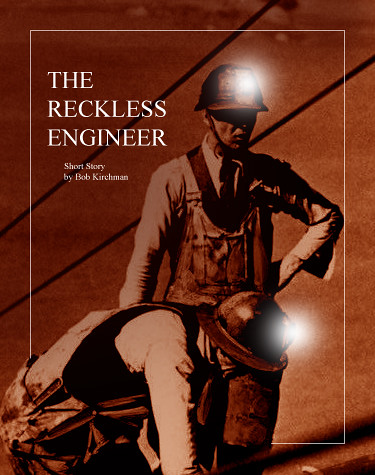
A Short Story by Bob Kirchman.
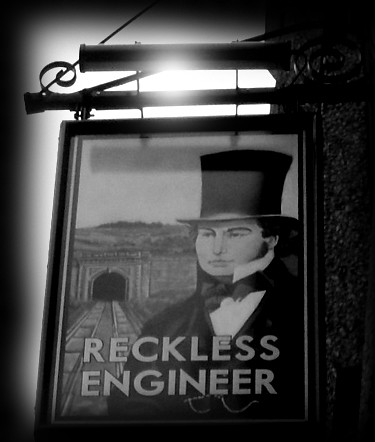
The Reckless Engineer
Short Story by Bob Kirchman
And all the people without dreams
Oh they laughed and oh they mocked in vain
You never needed monuments
Look at the Cornish sky and Bristol gorges”
-- Coast, ‘The Reckless Engineer’
Better drink up” the bartender said. “This is the last pub in the Western Hemisphere. Diomedes are dry and there’s only cheap vodka for 2000 miles after that.” The young couple, who were staying at the hotel complex in Wales, AK, were anxious about the next phase of their ‘Around the World’ tour. There was only an older gentleman sitting there with them in a corner of the room… nursing a gin and tonic as he sat musing. “He might be able to tell us,” the young woman opined.
Sure enough, the question as to the unusual name of the establishment caught his attention.
The Reckless Engineer... hmmmm, where do I begin. Well, the reference is to a gentleman who lived in the Nineteenth Century. He was Isambard Kingdom Brunel. Most people in the New World don’t have a clue, but the Brits revere him. He basically built the modern infrastructure of a great empire… railroads, tunnels, bridges, and great ocean-going ships! But it was a tunnel that almost killed him before his time.”
His father, Mark Brunel was a French expat and an inventor. He came up with a method of tunneling underwater and set to work to prove it by tunneling under the Thames. It still exists. It is part of the London Underground, but it was a daring move in the day it was built. The biggest problem was the uncertain composition of the earth under the river. It had been dredged and had unmapped holes in it. The younger Brunel was in charge of a crew excavating the bore and when water rushed into the tunnel, he was almost swept to a certain death. His assistant, a Mr. Beamish, plucked the young man to safety. Several colleagues who were with him were not so fortunate. They drowned in the rush of river water and sewage that flooded the tunnel.
Young Isambard went to the seacoast city of Bristol to recuperate. But he was not the sort to relax on holiday so he entered a competition to design a bridge to span the Avon Gorge there. Mind you, he’d never designed a bridge in his life, but he came up with several beautiful renderings for a suspension bridge over the gorge. Britain’s great engineer, Thomas Telford was to judge the contest. He rejected all of the entries and supmitted his own proposal. The people of Bristol hated it. In the end, Brunel’s beautiful design was chosen. The gorge was high and Brunel built a cable ferry to transport men and materials across it. Once when the basket snagged on the cable, young Isambard climbed out of the basket and hung precariously while he freed the mechanism. There is a pub in Bristol by the railway station that was the first to be named ‘The Reckless Engineer.’”
But why is this place, at the end of the world, also named ‘The Reckless Engineer’?” the young woman asked.
The Twenty-first Century was not so much unlike the Nineteenth,” the old man said. “After a period of great prosperity followed by great uncertainty, another engineer, perhaps not so young stood on the coast of Wales here, about to embark on the project that linked two continents. I’ll tell you a secret… HE’d never designed a bridge either. His Daughter and her husband provided most of the brain power for the actual design. The team of O’Malley and O’Malley are the real force behind the great bridge. Rupert Zimmerman was more of a showman. He convinced investors to back what was then a rather audacious undertaking. His daughter Elizabeth created beautiful renderings following the design laid out by her more practical husband.
And so, camped on the shore right where this hotel stands, Zimmerman and Martin O’Malley camped to survey the scene of their great work. If you go to the cheesy ‘Rupert Zimmerman Museum’ here in Wales, they’ll tell you how they heroically survived a fire that destroyed their tent and their provisions. They used their survival training to last the week there and returned to Nome as something of a sensation… but that is not the true story. O’Malley and Zimmerman stood on the shore of the Strait, drinking prodigious quantities of their favorite beer as they toasted their new venture.
They decided to go for a swim in the Strait. They didn’t think about how cold the water was and when they fumbled to build a fire they succeeded in burning up their tent!”
So, what about the part about him being in the war and all… what really happened there?”
Well, he really did lose a leg fighting in the battle of Anchorage and he went to Nome to recuperate. He idea for the great bridge came to him there and as his daughter came to Nome to care for him, she really did meet and marry O’Malley. They get that part right.”
And the part about him riding out the great storm on the partially built span?”
True as well, but I think Zimmerman really believed in the cable anchoring system and the pontoon span’s integrity. Soon enough the motoring public would be trusting the same system… not really as heroic as they make it out to be.”
And his childhood, hopping freight trains and all…”
Can’t deny it. I don’t think he was as brave as they make him out to be. Still, we’d all agree that he had a pretty amazing life.”
So, what’s next for him. The bridge just opened this past November. Now you can actually drive to Isambard Kingdom Brunel’s England on a highway. What does a man like that do… I guess he can retire and take life easy. Say, is it true that Brunel and Zimmerman were both short in stature and somehow driven by insecurity about it?”
I can’t speak personally for Brunel but I think you pretty well nailed it.”
The night passed quickly. The old man was a repository for so much information about the bridge and its construction. But he asked the young couple to tell their story as well. They somewhat nervously said that they had decided to embark on this adventure but that they had applied to the School of Engineering and Operations run by the Zimmerman organization in Wales. “I doubt if we have a shot at it, but we had to give it a try.” the young woman added. We met at Virginia Tech and discovered that we were more like this Brunel… reckless and all, than most of our colleagues. Sir, are you familiar at all with the school here?”
Oh, I know a thing or two about it.” The old man replied.
Is it true that they went back to the old bench-test and physical model methods from the old U.S. Space Program?” “Yes, it is true, and when you are there you will study these methods as well.”
The evening was growing late. The young woman remarked that she wished it possible that they could somehow find a way to get a ‘hard hat’ tour of the new biosphere being built on Big Diomede the next morning. “We’re staying here several days.” I don’t know who would be able to arrange that. If we could afford it, we’d be happy to pay.”
The old man wrote a phone number on a cocktail napkin and handed it to her. “Call this number in the morning, and depending on how long you are here for, you could see the new biosphere and some of the inner workings of the bridge as well.”
Oh, thank you so much! We’ll call first thing in the morning. You know we’d love to see as much as they are willing to show us! Say, who should we ask for, Mr… oh, I’m so sorry, I never learned YOUR name?”
Rupert,” the man responded, “Rupert Zimmerman, and I am quite pleased to meet you both.”
*********
You built the railroads from the West
You built the ships from iron ore and
All of your bridges never rest
But without love they're nothing more”
-- Coast, ‘The Reckless Engineer’
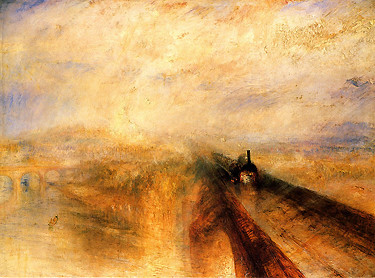
Rain, Steam and Speed - The Great Western Railway, by J. M. W. Turner. 1843
John and Alana (for that is the young couple’s names) arrived early the next morning at the offices of the Zimmerman Organization high in a tower overlooking the Strait. They were ushered into the reception area by a lovely young lady who had a distinct sparkle in her mischievous green eyes. “Hello, I’m Hannah,” she greeted them. “Mr. Zimmerman will be with you momentarily, but would you like some coffee?” “Uh, sure,” the young couple responded as Rupert’s receptionist zipped around the corner of her ample desk, grabbed a tray and dispensed their choices of beverage and placed it on a table by their chairs.
Please excuse my zipping about. My ‘Bionic’ leggings are being retuned today so I’m back in the chair for a bit. If you’d like, we could show you a bit of the research lab before you take the grand tour.” Alana’s eyes grew wide. “I’ve heard many amazing things about the lab. I would LOVE to see it!” She remembered the wonderful story of how Alexander Graham Bell had begun his research with the effort to give sound to the deaf. Here in the remotest part of the world, his legacy continued. “The lady who developed the assistive leggings and I work closely together,” said Hannah. “What is really cool is how they are truly assistive. They do nothing FOR me, but rather provide a little extra steam and steadiness to MY walking. You will see some amazing things happening here… artificial sight for the blind, direct transfer of sound to nerves, and a whole new level of prosthetics.”
We would love to see as much as you are willing to show us,” said John, “We are in no great hurry to venture off into Siberia.”
Good,” because we have three days worth of tour if you’d like it!”
This is what I call the ‘Labyrinth of Exile’” Zimmerman began as they walked through the tower’s endless corridors. “It’s named after a biography of Theodor Herzl, Father of the modern state of Israel, from where many of our brightest researchers hail from.” Indeed the small nation was well represented, as was most of the rest of the world in the serious faces that greeted them over the course of the next three hours. Zimmerman was clearly delighted to introduce every one of them, like the cherished family he considered them to be. “Don’t make the mistake of thinking me any less than the tough old bird you’ve heard me to be. I crack the whip around here!” “Yes Papa, you do,” said a young woman in white coveralls and a hard hat. She had slipped up behind them, placing herself deliberately behind the old man’s back… he feigned displeasure at her looking over his shoulder, but his face betrayed a deep love for the young lady.
Well, I suppose you should meet my GRANDDAUGHTER,” he said somewhat in a feigned disparaging way. “She will be with us tomorrow when we tour the great bridge, but today I wonder if she would be willing to show you our design rooms?”
On the boards were two great designs for covered entrances to the great bridge. If the bridge was spare and functional, the approach covers were anything but. They were drawn in the style of Santiago Calatrava, the great bridge architect. Zimmerman called them “Paddington Station” and “Temple Meade” after the great trainsheds of Nineteenth Century designer Isambard Kingdom Brunel. “We sort of specialize in ‘reckless engineering’ here,” he said. Zimmerman’s granddaughter chimed in: “Calatrava’s genius was that he saw the design disciplines as one and that the wonder of living things could guide you in it. Papa sent me to study under him for a while.”
Calatrava built bridges, buildings, even children’s toys, but his mind was the same in all of these disciplines. Nature, if you were quiet and observed it, was your true teacher.”
*********
All of the Reckless Engineer has gone And where now does heart and soul beat in the city sky?”
-- Coast, ‘The Reckless Engineer’
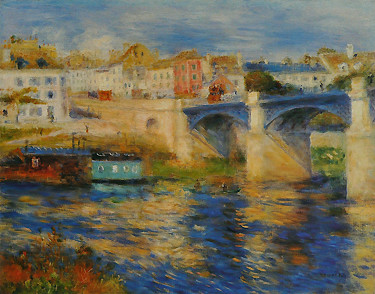
Le Pont de Chatou, Pierre Auguste Renoir
A bridge is a complex machine… or perhaps more like a living organism in that it moves and needs to be constantly renewed,” Rupert said as the little group entered the service stairway down into one of the great span’s floating piers. “In the Twentieth Century, great public works were authorized, heavily funded by the U. S. Federal government. In fact, they had a 90% match to 10% state funds. They did think of maintenance, it was supposed to have been funded by fuel taxes… but with the initial outlay for the bridges being so relatively cheap, it became all too easy for politicians to divert the funds that were supposed to be allocated for ongoing maintenance.
Fifty years after the great interstate highways were begun, an appalling percentage of the bridges on it were in questionable condition. Some of them actually failed outright.”
Alana and John soaked in the vast history of modern bridge building. Surely it was comforting to know that the operators of this bridge had learned some lessons from the past. Their tour had begun on the next morning… Saturday, but since they were on the International Date Line, the designation on operations calendars was Saturday/Sunday. Zimmerman had met them at the operations tower, beginning with the scores of monitor screens that allowed operations technicians to watch over the workings of Zimmerman’s ‘Darling Bridge,’ as he called it. That was a reference to Brunel’s affection for the Clifton Gorge span more than an infatuation of Rupert’s however.
Where is Hannah?” Alana asked? “Oh,” said Rupert, “She’s off today, but I suspect we’ll see her when we stop for lunch at the Big Diomede site.” I think she was going to paint landscapes with Mrs. Greene after church there today if the weather was nice.”
Sure enough, after a morning of ascending and descending into towers, piers and passageways, the entourage emerged on the large island in the middle of the strait to a balmy afternoon. The brief tundra flower explosion was brightly covering the wild plateau of Big Diomede and there overlooking the colorful display and the sea beyond, two women stood at easels painting en plein air. They looked like a Renoir painting themselves standing upon the verdant island. The wildness of this place dwarfed even the massive biosphere dome under construction. There was a raw beauty to this place and the timeless figures who painted it only added to its mystique. Under the freshly constructed dome a small lone house rose. Workmen were putting the finishing touches on it.
Rather than eat at the service plaza, I thought we’d prepare a nice picnic supper,” Mrs. Greene said after introductions. They were soon joined by Reverend Greene and Elizabeth Zimmerman O’Malley, Rupert’s daughter. It seemed like a fine Southern ‘dinner on the grounds,’ which indeed it was the remnants of, as it was Sunday on Big Diomede and the little church that met in the service plaza meeting room had indeed enjoyed such a feast earlier in the day. It was like a warm breeze from another Century… indeed even the driven Zimmerman seemed to slow down for it. John was impressed: “I did not expect food like I grew up on in… SIBERIA!” he exclaimed as he enjoyed a portion of macaroni and cheese that gained him a scornful glance from Alana, the health nut. But even she was obviously reveling in a bit of home so far from home.
Tomorrow I will give you the full tour.” Said Elizabeth, but today we will continue on with the inner workings of the great bridge. “Tonight,” Hannah said, “I would love for you to be my dinner guests at my condo in Wales. Would you?”
The day ended with the sun low in the sky and the last descent into a bridge pier where Rupert opened a hatch. His granddaughter smiled: “You’re showing them the fishing spot!” she happily exclaimed. Indeed they found rods and a small catwalk outside the hatch where they cast for some nice ocean fish. “We’ll cook them up at Hannah’s place,” Rupert said. “But I’m afraid I won’t be able to join you as this blasted cell phone is now giving me the message that we have an issue with the bridge seals in sector 217. I’m afraid I’ll have to set up a work zone tonight.
Indeed the dinner group shrunk to John, Alana, Elizabeth and Hannah. As they gathered in her condominium, Elizabeth took a call. The work on the seals was going badly. She excused herself. “My father will kill himself for his ‘darling bridge’ if I don’t go out to take some of the load off. Thankfully some of his senior guys have his back and call me like this.”
Tell me about the biosphere,” said Alana. “I just KNOW there is a story behind it.” Hannah looked about, walked over to her door and locked it. Slowly and deliberately she began: “When Mr. Z started this project, he was a pretty brash, no nonsense sort of ruthless industrialist. He ‘reaped where others sowed’ if you know what I mean. There is something you guys need to know about him. You’re in the program by the way, just don’t breath a word to HIM. I know though… I saw the look of satisfaction on his face when we met the relamping crew on the bridge. Alana, when you did not hesitate to climb up with the bulb… the man was one short, remember… you sealed your fate. I daresay the offer will be coming tomorrow.”
Hannah continued:
Zimmerman is a tough old bird, he fought in the battle of Anchorage and all, but when he began this great work people began to see another side of him. There was a young engineer and surveyor that he took under his wing. They went out to Siberia to lay out the road and discovered that it was like the Wild West out there. Trucks that broke down or wrecked by the side of the road were left there. After the local bandits looted them they set them on fire. Rusted and burning hulks were everywhere.
By the time you could get a recovery truck out there, the deed had already been done. The bandits would pull a driver out of his truck if it stopped out there and kill him.
Well, Mr. Z and this other young man were camped out there with plenty of guards… or so they thought, when they were ambushed and kidnapped. The bandits managed to pick off their security people. They took Mr. Z and his friend captive, knowing there would be big ransom money. When they missed Elizabeth’s frantic response and thought the money was being stalled, they took the young man away. That was the last time Mr. Z saw him alive.
The ransom money finally came and Mr. Z. was returned. When he returned to Wales he immediately organized a group of Alaska National Guard and they travelled back disguised as a road crew. When they got back to the site of the ambush, they discovered that the body of the younger man had been found in a cheap motel room in a trailer motel that was… well… not a nice place. The body was stripped and smelled of vodka. Rupert er I mean Mr. Z knew the man never drank. He was enraged that the perpetrators would sink to creating a sordid story. Zimmerman knew the man’s wife and children.
That was the only time I ever saw Rupert cry, and he wept unashamedly. I knew then that a man I had thought so cold and aloof loved deeply. He could be moved to tears by the loss of a cherished colleague.
He composed himself pretty quickly, however. His men could not get the local authorities to help them find the killers so in the end, in his great anger, he ordered everyone out of the motel buildings at gunpoint and soaked the place with petrol. Then he burned it to the ground. He returned to Wales visibly shaken but back to his old aloof self. He set up a trust for his friend’s widow and children and spoke at the memorial service of his fine service. But he was holding something inside that he couldn’t let go.
The flashbacks returned from his war days. Everyone thinks the reason he’s estranged from his wife Pat is that she doesn’t like cold places. The truth is he wakes up screaming… and he won’t seek help for it. He visits her regularly in Virginia but the truth is HE doesn’t want her here when he falls apart. He won’t let go of his anger and sorrow. I fear it is going to kill him one day!
The biosphere you saw today… its more than an environmental experiment… It is largely the creation of Elizabeth, but you must know that it is Rupert’s true ‘darling’ in that he sees it as an antidote to the “Hell on Wheels” he found across the strait. He claims to have no faith… that pretty much went away in his childhood he says. He ‘survived’ indoctrination by the ‘Sisters of Mercy.’ He says they showed none.
But he knew that his biosphere would be nothing more than glass and steel if it did not have some sort of a soul. That is why he convinced the Greenes to come up here. If you didn’t notice before, see how he lets down his guard in their hospitality. Tomorrow you must see the renderings Elizabeth and Mrs. Greene have prepared for the biosphere. These are not the works of one who merely desires austere efficiency.
I really don’t know why I am telling you all this, but I sense that you may indeed be in a position to help him. He allows Elizabeth and his granddaughter to come closer, but I feel like he’s a clock wound too tight… and working in two concurrent times, I fear he’s going to break!”
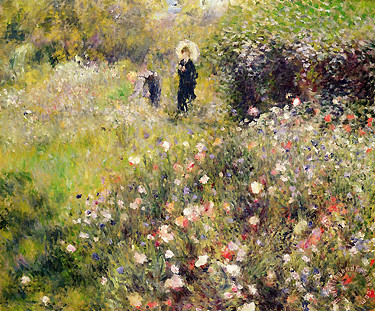
Summer Landscape, Pierre Auguste Renoir
*********
I am opposed to the laying down of rules or conditions to be observed in the construction of bridges lest the progress of improvement tomorrow might be embarrassed or shackled by recording or registering as law the prejudices or errors of today.”
-- Isambard K. Brunel
Sunday/Monday dawned early. Hannah greeted John and Alana at Zimmerman headquarters. “Elizabeth will be here in a bit,” she said. “Long night with the bridge seals!” A bleary-eyed Rupert popped out of his office: “How was dinner?” he asked.
Quite nice,” Alana responded, “And how did the work go on the seal problem?”
Zimmerman explained the seal problem… it seems that sustained temperatures combined with heavier stressed connections was taking more of a toll on them than anticipated. “Say John, you’re a materials guy. Would you look at this tech brief and when you get back here this Fall, would you like to have a go at it?”
Does that mean we’ve been accepted for the program then?” He responded. “Sure. Let me read this tonight. My thesis was on something similar with flexible pipe couplings. Maybe we can find a way to take some of the stress off of the seal itself in the meantime.”
I like that,” said Rupert. “Most guys just start wanting to remake the seal material straight off. You seem to have another tack. Tell me more.”
Well, sir, it seems the problem is exacerbated by the movement in the bridge. If we could add some sort of a stiffener, we could spread the stress better. I mean, you seem to be experiencing very localized failures at places the bridge moves more than others.”
So, in the minutes before Elizabeth arrived, the young couple had sketched out a pretty interesting clamping system that would spread the flexing evenly along the length of the span. Zimmerman was visibly impressed. “Hey, we could talk about this with your team tomorrow if you’d like.” Alana said. “That is, if you wouldn’t mind.”
When Elizabeth arrived, the congratulations were officially offered. Alana and John would sign on as mentees for their first year. They would be given accommodations and a small stipend until their year-end review, when they would likely be looking at $100K in petrodollars each per year starting salary. Of course, if the seal relief system played out, they would be receiving a bonus for that. Zimmerman, who had seen plenty of his ideas taken by employers with no attribution, had no problem sharing the glory when his own team, even the mentees, made valuable contributions.
But now it was time to head over out to Big Diomede, a half-hour drive West on the bridge. Elizabeth drove John and Alana across the span… but she spoke little. She was tired, sure, but clearly something was on her mind. “I’ve never seen someone get accepted so quickly,” she mused quietly. “You know, John, you remind me of…” she caught herself and was silent for the remainder of the trip. It seemed a long half-hour indeed and when the car finally reached the Big Diomede site, everyone was relieved when Mrs. Greene greeted them. She had worked with Elizabeth in the creation of the Biosphere and sure enough, the renderings of the proposed complex were stunning. It was something out of another Century so far as its craftsmanship and execution. The parsonage was the only building built so far, but it was simple and beautiful; quite a contrast to the prefabricated world of Wales. A lone tree, freshly planted, graced the yard. Nearby there was a footer where stonemasons were laying the first course of a more substantial building. Elizabeth pointed to a painting of a gothic chapel… “A memorial to a man who lost his life in the service of the Zimmerman Organization,” said Mrs. Greene. “The chapel will be home to our church here.”
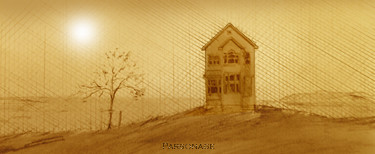
The biosphere was a fascinating place. Artificial sun-spectrum lighting was being installed along the bars of the geodesic dome which had ionized panels that could be clear for natural light but could be clouded to reflect the light from the lamps down. Huge rigs were drilling down to provide thermal heating. Nursery workers were planting quick growing shrubbery to provide air refreshment inside.
At lunchtime, the Greene’s again hosted what Mrs. Greene referred to as ‘Elevensies.’ This time in their newly finished dining room. “Tell me about the man who the chapel memorializes,” Alana said to Kris Greene as John and Elizabeth were in deep discussion of geothermal piping following their delicious lunch. “Oh,” said Kris, “I myself never knew him… but I understand he was a close friend of Rupert’s. They were working on the Great Western Road alignment in Siberia, I think, when…” Elizabeth interrupted: “I think we’d better get on with our tour now. Thank you, Kris, for your warm hospitality.”
Back at Wales, Elizabeth was summoned by her cell phone… the bridge never ceased to call on her keepers, it seemed. She apologized for her demeanor. “Rough day, it has been,” she said. Hannah was there, eager to show the young couple some of the photos on the wall in the lobby. “Here is the place where we were drilling for oil, but Rupert discovered that the people were all sick for lack of water. Well, he threw a curve-ball into the calculations for the lateral drill. When it gushed not oil, but fresh water, his crew groaned at his ‘mistake,’ but when he capped it the people had a good and steady supply of safe water. Everyone here sort of goes along with the legend that he’s a real cheapskate… but you did see the beginnings of the Big Diomede Chapel, didn’t you. That is not a shabby piece of work at all.”
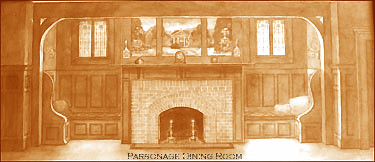
Rendering by Lola Dalton, 1914, the Author's Grandmother.
Alana spoke: “Do you mind if I ask you, ah, about Mrs. O’Malley; what is it that is troubling her? When we were accepted, I mean, it seemed she has some great reservations or something. Look, we don’t want to come here if you have any doubt that is sincerely based.” Hannah thoughtfully replied: “This is not the time or place, but please come to my place tonight and we’ll talk further. My husband is in the ‘lower 48’ representing our interests in Washington, a thankless part of his job. I’ll be glad when he’s done, but in the meantime it would be wonderful to have some company!”
We don’t say his name here,” Hannah said softly… “Rupert’s colleague who died in the Taiga, but it is clear that he… and his daughter Elizabeth, see the resemblance. He was young, reckless and would go to the ends of the earth… but he had a young family. I would imagine Elizabeth sees her father performing penance, if you will, for the death of his trusted friend. Oh, don’t sweat that. I’ve reviewed your qualifications. You are more than what we require in every way, but I think you will have to deal with the fact that Rupert sees in you an unfinished life. He’s not going to go easy on you, mind you, his granddaughter is the apple of his eye, but he rode her harder than the rest of them. I do not think Elizabeth’s unspoken fears are rational, but fears seldom are.”
So, what shall we do?,” Alana asked.
I don’t know, really, but I suspect that in time this will prove to be a good thing. You came here prepared to be patient, and the present situation requires plenty of that. Elizabeth is quite protective of her father, and I think she has good reason, but she is fair minded. I think you will prove yourself in the end and you will find her a lovely person to work with. In the meantime, I think it best to avoid discussion of a certain unfortunate occurrence… and of Rupert’s attempt to remember it.”
Rupert Zimmerman awoke that night screaming. He came to himself in a cold sweat and got up and checked the lock on his door. His was the top apartment in the condominiums over the workspaces and Elizabeth and Martin were directly below. He hoped he hadn’t disturbed them, but he knew full well that he had. He didn’t know that Hannah’s apartment, though it was further away, allowed her to be disturbed as well. Rupert Zimmerman was a man who professed no need for the Divine… but in the endless night, as Rupert raised the blinds in the hopes that the midnight sun would free him from his prison, his daughter, son-in-law and his devoted assistant prayed to the God Rupert spurned. Back in Virginia, Pat couldn’t sleep. Rupert weighed heavily on her mind. Thirty miles away from Wales, as a new day began at the end of the world, a young woman took her husband’s hand to pray as well: “I’m concerned for Elizabeth’s father.” She prayed. Though Zimmerman would have scoffed at the very notion, his friends that moment were speaking in unison to that God, pleading for the deliverance that only He could give.
If we must have heroes and wars wherein to make them, there is no war so brilliant as a war with the wrong, no hero so fit to be sung, as he who has gained the bloodless VICTORY of truth and mercy."
-- I. K. Brunel
(the Reckless Engineer is the Prelude to PONTIFUS [6.])
Copyright © 2017, The Kirchman Studio, all rights reserved
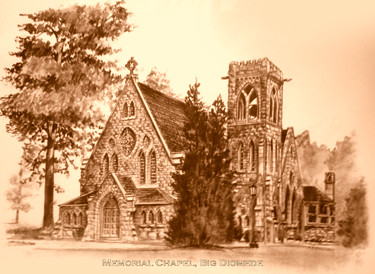
PONTIFUS, The Bridge Builder's Tale
[click to read]
The History of Serial Fiction
Serials have existed in fiction for a very long time. Books were expensive back in the 19th century, so they were printed in installments in order to keep the price low. Charles Dickens, often heralded as one of the greatest early self-publishers, was also one of the most successful writers of serialized fiction. Another big name, Alexandre Dumas, was a very prolific serial novelist, publishing both The Count of Monte Cristo and The Three Musketeers in serial format. In fact, serialization worked so well, it was considered the way to go by popular authors during the time." -- Samantha Warren
THYME Magazine presents, in serial form, the story of a man who challenged the proposition that something he wanted to achieve was "impossible." Based on history, depicted in the future, Pontifus is a tale of human triumph in the face of challenges such as face us today. (read more)
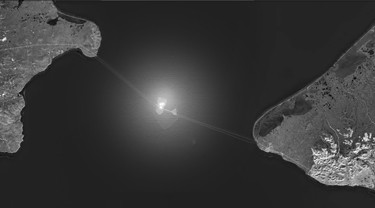
Sunlight reflects from the biosphere domes of Big Diomede in this photograph of the Bering Strait Bridge from space.
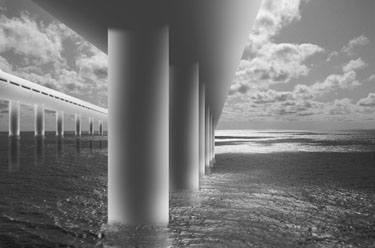
The twin spans of the Bering Strait Bridge. The original span (closest) is the Charles Alton Ellis Memorial Bridge. The second span is the Joseph Baermann Strauss Memorial Bridge.

The twin spans stretching to the West and Asia.
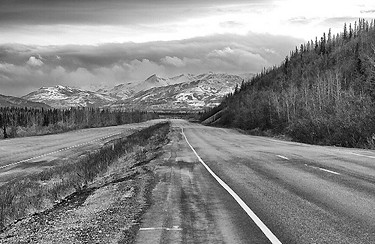
Alaska A2.
Copyright © 2017, The Kirchman Studio, all rights reserved
New 'Old' Architecture
The Inspiration for the Buildings of Big Diomede
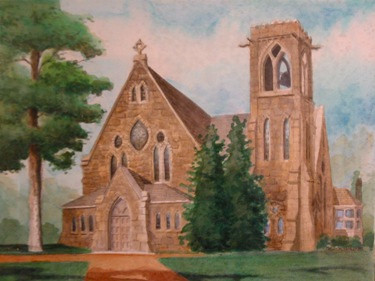
The Church on Big Diomede is based on my painting of the University of Virginia Chapel.

My Grandmother, Lola Dalton Carpenter, designed this window for a stairwell in 1914. I carried it into the Twenty-first Century as a window at the College on Big Diomede.
At the turn of the Century, as the Twentieth Century began, the great world's fairs presented a vision of civic architecture for America's young cities. A beautiful classicism prevailed, inspired by the model of Greek and Roman architecture. As the McMillan Plan transformed Washington DC into a very beautiful city, it put in place a sort of architectural order. The civic buildings of the metropolis all followed the form of Greek and Roman architecture. The great Cathedral and Catholic shrine rose in Gothic and Byzantine forms, thus creating a wonderful order for religious architecture as distinctive.
For Big Diomede, it seemed appropriate to again visit the past for ordering the future. Thus I returned to classicism for the College and Gothic for the Chapel, the precedent being Thomas Jefferson's University of Virginia... a beautiful campus in the Palladian style. Jefferson omitted a place of worship, perhaps by design, but in the 1880's a chapel Designed by Baltimore architect and University alumnus Charles Emmet Cassell was erected. The chapel’s materials, site, and style signify it as a Christian building in contrast to the Academical Village. Upon the chapel’s dedication, Professor Maximilian Schele de Vere proclaimed that while the Rotunda represented “in cold though classic beauty the outlines of a pagan temple,” the chapel aspired to Heaven with its “pointed window” and “flying buttress.”
In 1980 I was married to my beautiful wife in that chapel, about a century after it was first proposed. Thus that building is very special to me. The Zimmerman Stone Mountain Proposal Story is the story of my own proposal! Yes, the Divine sent a Storm! We like to think it would have happened anyway, without the Heavenly pyrotechnics, but it remains a great story.
Grandma's window and Inglenook found their way into the story simply because the images fit the mission, and I love them. She was a student at the Maryland Institute in 1914 and produced most of her work in those years. She married O. F. Carpenter, a successful Madison businessman and painted as an avocation until her eyesight failed in the 1970's. Lola Dalton Carpenter was extremely talented and had studied fashion design. In a later part of the story, yet to be told, a nod to Kris' efforts in this discipline is really a shout to Grandma, who all of us credit with our own creative impulses. My cousin in Oregon is an incredible photographer. My own children are very good too. We all thank Lola Dalton Carpenter for blazing the creative path for us!
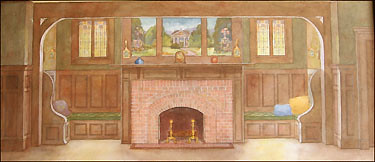
My Grandmother, Lola Dalton Carpenter, designed this ingelnook in 1914. Of course, it was exactly the look I wanted for Kris' house on Big Diomede.

I added the chalk drawings in front of one of my renderings to create the exterior.
Copyright © 2017, The Kirchman Studio, all rights reserved
The Reckless engineer, available at: www.coastrock.co.uk
Big Diomede Biosphere
'Construction' photos created by Bob Kirchman
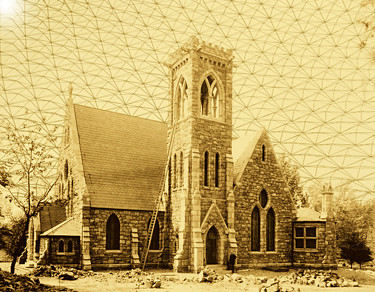
The Church under construction.
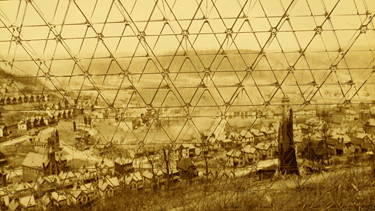
Houses around the new college.
Bridges
Paintings by Savhanna Herndon
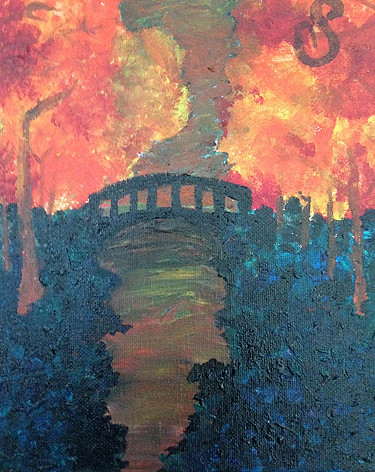
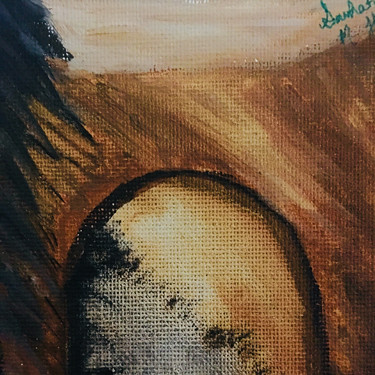
But between them and the foot of the sky there was something so white on the green grass that even with their eagles’ eyes they could hardly look at it. They came on and saw that it was a Lamb. “Come and have breakfast,” said the Lamb in its sweet milky voice. Then they noticed for the first time that there was a fire lit on the grass and fish roasting on it. They sat down and ate the fish, hungry now for the first time for many days. And it was the most delicious food they had ever tasted. “Please, Lamb,” said Lucy, “is this the way to Aslan’s country?” “Not for you,” said the Lamb. “For you the door into Aslan’s country is from your own world.” “What!” said Edmund. “Is there a way into Aslan’s country from our world too?” “There is a way into my country from all the worlds,” said the Lamb; but as he spoke, his snowy white flushed into tawny gold and his size changed and he was Aslan himself, towering above them and scattering light from his mane. “Oh, Aslan,” said Lucy. “Will you tell us how to get into your country from our world?” “I shall be telling you all the time,” said Aslan. “But I will not tell you how long or short the way will be; only that it lies across a river. But do not fear that, for I am the great Bridge Builder. And now come; I will open the door in the sky and send you to your own land.” – C. S. Lewis, Voyage of the Dawn Treader
The Bridge Builder
Poem by Will Allen Dromgoole
